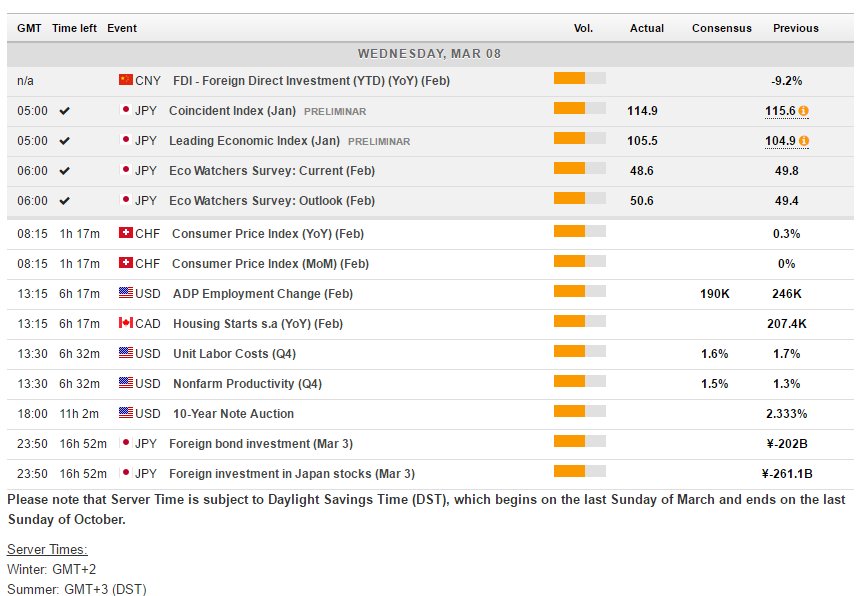FX News
European Outlook: Core European bond yields remain under pressure, peripheral Eurozone markets are underperforming and equity markets are holding back as investors remain cautious going into Thursday’s ECB meeting, Friday’s U.S. jobs report ahead of the Fed decision next week. Much weaker than expected German manufacturing orders data on Tuesday have taken some pressure off Draghi to at least remove the reference to the possibility of further rate cuts from the forward guidance. QE remains in place for now and officials will remain adamant that the planned reduction in monthly purchase volumes from next month does not constitute “real tapering”, that is a gradual phasing out of asset purchases. That this will come next year is highly likely and widely expected, although with Eurozone elections and Brexit talks looming, we expect Draghi to keep his insurance policy in place for now and not move to real tapering before December, when the end of the current purchase program draws near. The calendar features Geman production and Swiss CPI data.
US reports: The U.S. trade deficit widened to a 5-year high of $48.5 bln from $44.3 bln in December and a 9-month high of $45.5 in November, with mostly upward revisions for both exports and imports of services that generally narrowed the gaps back through 2016. The deficit was $0.5 bln narrower than indicated by the “advance” trade report with upside surprises in both exports and imports, though we still peg Q1 GDP growth at 1.5% after a Q4 growth boost to 2.0% from 1.9%. The Q4 GDP growth boost should include a $2 bln downward bump for exports and a $1 bln boost for imports, alongside an already-signaled hike of $5 bln for inventories and $2 bln for construction.
Germany: German manufacturing orders were much weaker than expected, with the overall number falling -7.4% m/m in January, more than wiping out the 5.2% m/m rise in the previous month. Bundsbank data showed the three months’ trend rate slowing down to just 0.2% from 4.0% in the three months to December. The numbers contrast sharply with the robust round of confidence numbers for February and cast a shadow over the outlook, as they point to a slowdown in growth in the second quarter. More backing for the arguments of the doves at the ECB council for Thursday, who will want Draghi to confirm the easing bias and the ongoing QE schedule despite likely upward revisions to growth and inflation projections.
Canada: Canada’s Ivey PMI dipped to 55.0 in February on a seasonally adjusted basis from 57.2 in January. The employment index improved to 54.5 from 53.5, prices dropped to 61.1 from 70.1, supplier deliveries declined to 45.9 from 46.6 and inventories were 51.4 from 46.4. The Ivey PMI has been in expansionary territory since June of 2016 after the 49.4 seen in May of last year. Moreover, the six-month moving average improved to 58.0 in February from 57.5 in January and December, consistent with ongoing momentum in the economy. Also, the Ivey PMI improved to 55.1 in February on a not seasonally adjusted basis from 52.3 in January and 49.4 in December, consistent with the usual seasonal pattern and broadly supportive of our outlook for continued momentum in Canada’s economy during Q1. Canada’s trade surplus widened to C$0.807 bln in January, nearly as expected, but December was cut to a C$0.447 bln surplus in December from the C$0.9 bln initially reported. Export values grew 0.5%, driven by motor vehicles and canola oil shipments.
Japan: Japan GDP was revised slightly higher to a 1.2% pace in Q4 (q/q, saar) from the initial 1.0% pace. GDP grew at an identical 1.2% rate in Q3 after the 2.2% gain in Q2 and 1.9% clip in Q1. The revised Q4 growth rate fell short of projections. Consumption growth remained flat in Q4.
Main Macro Events Today
- Canada Housing Starts – Housing Starts expected to slow to a 200k unit rate in February from 207.4k in January. Bank of Canada Governor Poloz has maintained that the October 2016 housing measures from the Ottawa will mitigate some of the risks (associated with housing) going down the road. But he cautioned that these things move slowly. Building permit values are seen falling 1.0% in January after the 6.6% tumble in December.
- US ADP Employment Change – February ADP Employment report should post a solid 184k gain for the month, but below the January figure of 246k.
- UK Annual Budget Release – Spring’s Budget Report and the first of 2017. Tax hikes expected to be announced.
Click here to access the HotForex Economic calendar.
Want to learn to trade and analyse the markets? Join our latest webinar and get analysis and trading ideas combined with better understanding on how markets work.
Click HERE to register the next webinar will start in:[ujicountdown id=”Next Webinar” expire=”2017/03/08 11:00″ hide=”true” url=”” subscr=”” recurring=”” rectype=”second” repeats=””]
Andria Pichidi
Market Analyst
HotForex
Disclaimer: This material is provided as a general marketing communication for information purposes only and does not constitute an independent investment research. Nothing in this communication contains, or should be considered as containing, an investment advice or an investment recommendation or a solicitation for the purpose of buying or selling of any financial instrument. All information provided is gathered from reputable sources and any information containing an indication of past performance is not a guarantee or reliable indicator of future performance. Users acknowledge that any investment in FX and CFDs products is characterized by a certain degree of uncertainty and that any investment of this nature involves a high level of risk for which the users are solely responsible and liable. We assume no liability for any loss arising from any investment made based on the information provided in this communication. This communication must not be reproduced or further distributed without our prior written permission.



















